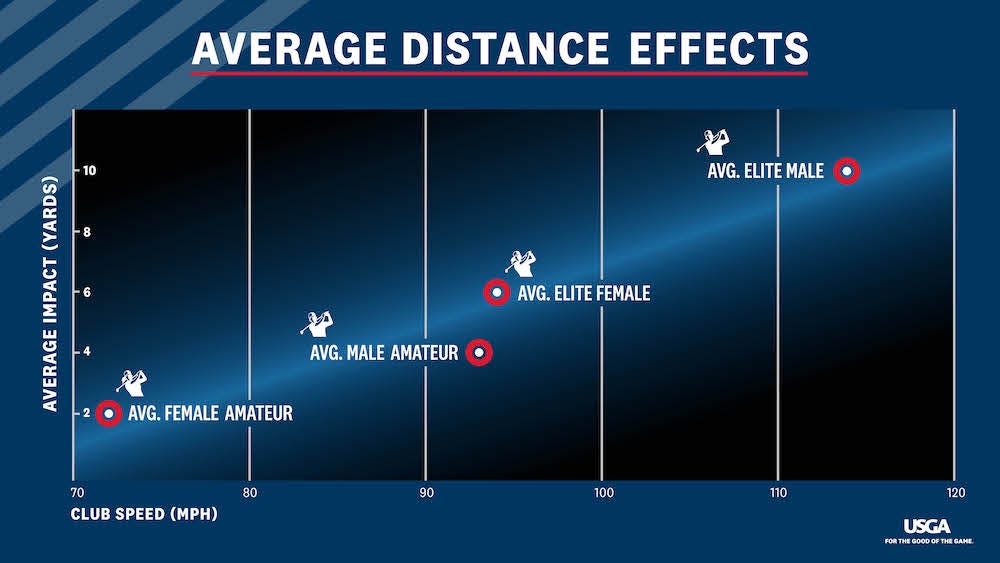Answering Cousin Eddie's Distance Claims
Christmastime means tolerating relatives channeling shallow, bizarre and even irrational grievances aimed at the USGA and R&A.
The USGA and R&A’s announced change in golf ball testing elicited the predictable onslaught of rage-whining, threats of quitting, misinformation peddling, and overall, a prime opportunity for First World grievance groaning. All of it over so very little. And for new testing rules that will not go into effect until 2028 for elites, 2030 for everyone else once they’ve run out of the golf ball stockpiles they’re starting.
Quadrilateraldistanceistas should expect to be confronted with pitiful gripes during your Christmas gatherings. But think of it this way: arguing about distance beats talking about LIV!
In a world populated with far more Cousin Eddies than we ever imagined, this special subset of the population has never felt more emboldened to openly glom on to any rage campaign no matter how little it means to their life. Some have been inspired to complain after hearing their favorite influencers sling sob stories about how, just when the game is finally growing thanks to white belts, hoodies, flat brims and the chance to overpay for distance, along comes this terrible setback. Cousin Eddie is not smart enough to recognize that these influencers and media outfits are just channeling corporate-crafted talking points.
So while I’m aware how futile it may be to battle Cousin Eddie given that his Dorito-and-dip diet makes it unlikely he’ll be above ground by 2030 when all amateurs must play a ball that might go five yards less far, think of it this way: pushing back on the stupidity means less time listening Cousin Eddie’s gripes about Bud Light, how he burned his Travis Kelce jersey and how Walt Disney conspired with Nazis to stage the moon landing.
Which is my I’m here to fortify the Clark Griswold to your Cousin Eddies. Shall we?
When Cousin Eddie threatens to quit a game over losing distance, ask him what his clubhead speed is. Eddies rarely know their numbers. Which means Eddie (A) has never been on a launch monitor and, (B) stands to gain yardage by getting a lesson or fitting. On the off-chance he does know his number, subtract 10 m.p.h. from what he tells you and show him this chart estimating what he and his buddies might lose six years from now if they bought the new ball.
How to respond whe Eddie says the USGA and R&A are picking on average golfers. Tell him how the PGA Tour and PGA of America—and you may need to explain the difference since major publications across the globe still struggle with this—announced how they opposed bifurcation of the rules to protect Eddie’s ability to buy a 215-yard wipe cut that he thinks is a 300-yard bomb. Wait. Don’t use bifurcation. Try “separate rules for pros” that were opposed by the PGAs. And also point out that everything from the baseball bat to the javelin to the NFL football is regulated to maintain the integrity of the playing fields since it’s easier to change equipment than a stadium.
When red-blooded capitalist Eddie says this is all unfair to corporate America because the poor beleaguered equipment companies need more time to make the new ball. Eddie has heard the cries from various Twitter/ball company flacks who say there will be a huge burden on for-profit companies to research, retool and realign ball factories. He’s heard a dozen balls may soon cost $80 just to pay for the research! Except that the companies already have about 1300 different golf balls on the current conforming ball list, including 15 under the “ProV1” banner alone (and we know Eddie only plays the best!). This might indicate they are more flexible than he’s been told.
Yes, but Eddie says it’s really, really hard to make a premium product and if anyone knows premium, it’s Eddie. There are generally two parts to the construction of a modern golf ball: the cover and the core. Sometimes there are added layers for marketing or super-specific needs like launch monitor-specific balls (which also happen to be unprofitable). A typical automobile has around 30,000 parts. The slimmed down Tesla still has around 10,000 or so parts. Yet car companies update models every few years or sometimes annually. You can remind Eddie that the ball companies have already secured patents and trademarks on a “rolled back” back. Some even already submitted balls for testing under the proposed and since-softened testing parameters from 127 m.p.h. to 125 m.p.h. They can do this!
When Eddies says everything currently on the market will be non-conforming because Golf Digest and Sirius XM’s Michael Breed said so (Eddie doesn’t have subscriptions to either service but he heard this from his buddies). The USGA and R&A estimate that 30% of the current conforming ball list will conform under the new standards. Unfortunately, it will be up to the manufacturers to tell us which balls conform on the off-chance competitors want to see what it’ll be like to go back to the future. I realizet here’s a better chance of Eddie finding a job than getting this list of balls from the companies. Unless these companies finally realize they are missing out on the chance to be first in establishing the 2030 product that might also give golf a much-needed high-end (but limited-flight) range ball.
The USGA and R&A do not understand the plight of the poor AJGA kids who get their balls Huck Finn-style searching for lost balls in their spare time. And don’t even think about getting Eddie started on lake ball divers who live paycheck to paycheck and now will now be put out of business. You can remind Eddie that the Rules of Golf are optional. Freedom! That’s right, any company is free to make whatever they want. Golfers are welcome to ignore the rules and can even buy non-conforming stuff. If only companies had the courage to make it! You may have to explain to Eddie that these extra-whiny companies refuse to make “non-conforming” equipment because they know the market is tiny. You can also ask Eddie why companies pay a licensing fee to place “conforms to the Rules of Golf” on packaging of the current distance-restricting stuff, all while steadfastly refusing to make non-conforming equipment?
Eddie heard PGA Tour types and club pros receive the same stuff that amateurs pay for and the game can only grow because of this connection. The only time pros buy off-the-shelf stuff happens when they’ve just finished a round with 39 putts, then hurled their putter into the 18th hole pond, and were forced to stop at the local Dick’s to buy a new short stick. “Elite pros and ball manufacturers think bifurcation would negatively affect their bottom lines, when in reality, the game is already bifurcated,” said Rory McIlroy. “You think we play the same stuff you do?” Explain to Eddie that was a rhetorical question from young Mr. McIlroy. And what a rhetorical question means.
The governing bodies refused to accept that progress is vital to growing the game, Eddie declares while using a big word like progress. As recently as 18 months ago during the Distance Insights process, an opportunity was still on the table for manufacturers to offer ways of loosening rules to “allow for continued innovation of balls and clubs for players at all levels.” Feedback was negative on the idea and it was dropped. The companies apparently only know how to sell the public what the pros play.
If Eddie lives to 2030 and loses five yards of distance off the tee when the conforming balls go into effect, remind him that he will not be the only golfer on earth to lose distance. Nor will the game be less enjoyable to play or watch. There is even a chance it might get more interesting to see players like his beloved Bubba Watson move the ball when hitting a long iron into a green. Padraig Harrington: “Enjoyment is based off your current expectations. If you expect to be 10 yards short of your playing partner and you hit it 10 past them you are happy no matter if it’s 300 or 200 yards. It’s always relative to your expectations.” And McIlroy said: “I don’t believe an average golfer giving up 5-10 yards off the tee is going to have a material effect on their actual score, handicap or enjoyment of the game.”





